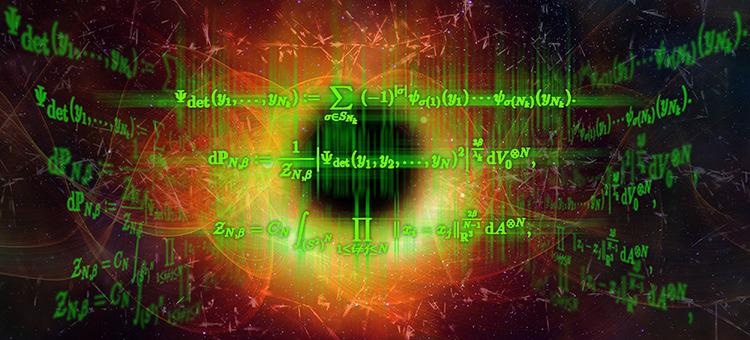The study questions how Einstein’s theory of gravity can be integrated with quantum mechanics. This breakthrough could offer a deep understanding of phenomena like black holes and the birth of the universe.
 The quantum mechanical description of black holes is still in its infancy but involves spectacularly advanced mathematics. Image Credit: University of Gothenburg
The quantum mechanical description of black holes is still in its infancy but involves spectacularly advanced mathematics. Image Credit: University of Gothenburg
A recent study published in the journal Nature Communications, written by scientists from the Chalmers University of Technology, Sweden, and MIT, USA, presents outcomes that shed new light on significant challenges in comprehending quantum gravity.
As far as modern theoretical physics is concerned, the biggest difficulty is determining a “unified theory” that can explain all the laws of nature within a single framework connecting Einstein’s general theory of relativity, which explains the universe on a large scale, and quantum mechanics, which describes the world at the atomic level. Such a theory of “quantum gravity” would consist of both a microscopic and macroscopic description of nature.
We strive to understand the laws of nature and the language in which these are written is mathematics. When we seek answers to questions in physics, we are often led to new discoveries in mathematics too. This interaction is particularly prominent in the search for quantum gravity—where it is extremely difficult to perform experiments.
Daniel Persson, Professor, Department of Mathematical Sciences, Chalmers University of Technology
An example of a phenomenon that needs this type of integrated description is black holes. A black hole develops when an adequately heavy star extends and falls under its own gravitational force. Thus, all the mass it has is concentrated in an extremely small volume. The black holes’ quantum mechanical description is still in its beginning stages but involves spectacularly advanced mathematics.
A Simplified Model for Quantum Gravity
“The challenge is to describe how gravity arises as an ‘emergent’ phenomenon. Just as everyday phenomena—such as the flow of a liquid—emerge from the chaotic movements of individual droplets, we want to describe how gravity emerges from quantum mechanical system at the microscopic level,” states Robert Berman, Professor at the Department of Mathematical Sciences at the Chalmers University of Technology.
In a study that was reported recently in the journal Nature Communications, Daniel Persson and Robert Berman, collaborating with Tristan Collins of MIT in the USA, displayed how gravity arises from a special quantum mechanical system, in a simple model for quantum gravity known as the “holographic principle.”
Using techniques from the mathematics that I have researched before, we managed to formulate an explanation for how gravity emerges by the holographic principle, in a more precise way than has previously been done.
Daniel Persson, Professor, Department of Mathematical Sciences, Chalmers University of Technology
Ripples of Dark Energy
The new research could also shed light on the perplexing phenomenon of dark energy. In Einstein’s general theory of relativity, gravity is explained as a geometric phenomenon. Similar to how a newly made bed curves under the weight of a person, heavy objects have the potential to bend the universe’s geometric shape.
However, as per Einstein’s theory, even the empty space — the “vacuum state” of the universe — consists of a rich geometric structure. If one could focus and observe this vacuum on a microscopic level, quantum mechanical ripples or fluctuations called dark energy could be seen. From a bigger perspective, it is this mysterious form of energy that is accountable for the expedited expansion of the universe.
This new work might give new insight into how and why such microscopic quantum mechanical ripples arise. It also explains the relationship between Einstein’s theory of gravity and quantum mechanics, which is something that has eluded researchers for several years.
These results open up the possibility to test other aspects of the holographic principle such as the microscopic description of black holes. We also hope to be able to use these new connections in the future to break new ground in mathematics.
Daniel Persson, Professor, Department of Mathematical Sciences, Chalmers University of Technology
Journal Reference:
Berman, R. J., et al. (2022) Emergent Sasaki-Einstein geometry and AdS/CFT. Nature Communications. doi.org/10.1038/s41467-021-27951-9